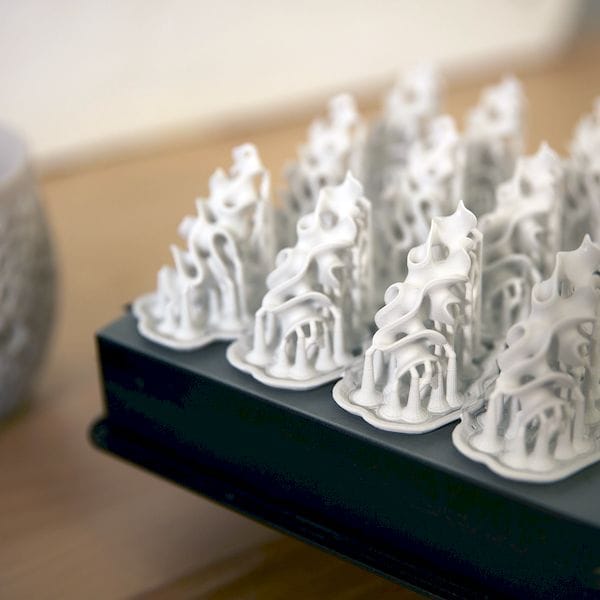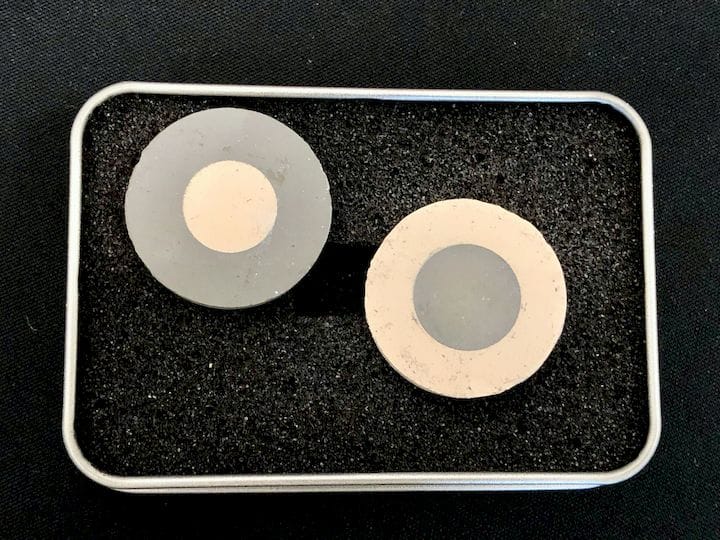
This week’s question relates to the costing of ceramic 3D printing.
Fabbaloo reader James asks:
“I’m working on jewelry collection with another designer, and interested to understand the cost variables for a single print (prototype), and if there is a price difference for bulk production. Overall we are trying to understand the whole process and pricing, delivery time etc.”
This is a big question, and I’m sure you’re not surprised the answer is “it depends”, but let’s examine some of the factors involved so that you and other readers can understand this a bit more.
Ceramic 3D Printing
3D printing ceramic material is a fairly rare thing, as there are few vendors offering it as compared to polymers or even metals. One reason for this is that designers of ceramic parts have, in general, not yet discovered radically new ways to leverage the technology as has already happened in aerospace, dental and automotive industries. When there’s less demand, there are fewer solution options.
That said, there are several companies specifically focusing on ceramic 3D printing capabilities, including:
There’s another option, and that’s to make use of a ceramic 3D printing resin in an SLA-style 3D printer, of which there are many options. However, those are not optimized for ceramic production as equipment from the above vendors might be. An example of this could be using Formlabs’ printers with their ceramic resin.
Most of these products require notable post-processing. Ceramics are frequently 3D printed with a binder that must be removed, and the remaining ceramic particles must be sintered together. This requires a sintering furnace, which is a piece of equipment required in addition to the ceramic 3D printer itself.
3DCeram offers a pretty useful chart showing the typical steps involved in producing 3D printed ceramic parts.
Choosing A Ceramic 3D Printer
With all these options you might think it’s pretty easy to make a selection, but that’s not exactly how it works. Each of these machines offers different capabilities and results, and usually the machines are targeted at very specific applications. For example, ExOne’s and voxeljet’s machines are designed to make very large ceramic molds for casting metal parts. Probably they are not suitable for a jewelry application.
As with every 3D printing project, the first consideration must be an examination of the desired result. In this case you specify jewelry, so this means the build volume does not have to be particularly large, unless you plan on producing large volumes. In that case a large-format ceramic 3D printer with high resolution might be suitable to crank out many copies in each build job.
An appropriate device for this project would likely also require very good resolution, as jewelry is a product that is seen and handled.
Of the list of vendors above, the ones you might consider using for fine jewelry 3D prints could include:
- 3DCeram
- ADMATEC
- AIM3D
- LITHOZ
- PRODWAYS
- Tethon3D
- XJET
- Formlabs or similar SLA printer using ceramic resin
Another consideration is the material required for the product, as each vendor tends to use only very specific materials. For example, ADMATEC offers only Zirconia, Alumina, Silica and Hydroxyapatite. If one of these matches the requirements either by name or by physical properties, then great. But if the vendor does not offer the required material, then you’ll have to consider another vendor’s equipment.

Some vendors offer unusual capabilities. For example, XJET has been able to produce 3D prints made of both metal and ceramic, a feat yet unmatched by any other ceramic 3D printing vendor.
Cost of Ceramic 3D Printing
The cost of ceramic 3D prints is going to vary considerably depending on what is printed and how it’s done. Each vendor has different pricing schemes. For example, the Formlabs option might be quite inexpensive as compared to other options that cost in the multiple six figures, just for the equipment. On the other hand, you might be forced to use one or more vendors simply due to material availability.
Cost factors include:
- 3D printer
- Associated post-processing equipment (like a sintering furnace)
- Materials
- Labor
- Housing the equipment (power, air, filtering, etc.)
Labor costs vary as well because the processes used by each machine can be somewhat different and thus more or less effort is required to execute a job.
One could compute the cost of a single print, but if you’re doing multiple copies, then things get complicated. Depending on the build volume and type of 3D printing process, you might be able to print multiple copies in a single build job. There are fixed costs required to set up, load and unload the device, and there could be some economy of scale when doing larger production runs. On the other hand, materials cost about the same regardless of how much you buy, so that won’t be a factor with larger unit counts.
The Service Option
If all this sounds complex, you’d be correct: setting up a ceramics 3D print production line is a non-trivial task. Not only would you have to corral all the required equipment and materials, you’d also have to learn how to execute the process. That can be tricky, particularly the post-processing steps. For a smaller project it may not be worth the cost to set all this up.
One very good option could be to leverage a 3D printing service. By doing so one can take advantage of existing operational skills at the service bureau, and avoid the big one-time cost of setting up equipment and learning how to use them properly. The service will certainly charge a bit of a premium over the raw cost of production, but that is likely to be far less than the cost of setting things up yourself.
Unfortunately many of the popular 3D print services do not offer ceramics 3D print services, but many of the ceramic 3D printer manufacturers do offer such services.
Ceramic Recommendation
If this were my project I would strongly consider using a service, as I have little interest in setting up a ceramics production line for a project. Services are readily useable and can turn around projects quickly, far faster than one could set up one’s own system.
Here’s the steps I would take:
- Complete a preliminary design for a jewelry product
- Select several services offering ceramic production
- Have the services review your design to ensure it is printable on their equipment
- Adjust the design if required
- For each service, select a material that best matches the requirements and order a test print
- Evaluate all the prints received for quality and costing
- Select a winner and have them print as many as you require
That’s likely to be the fastest way forward on a ceramic project.
